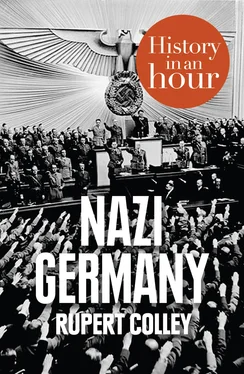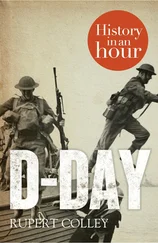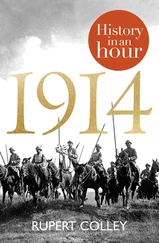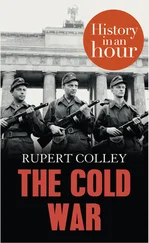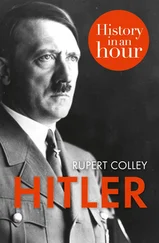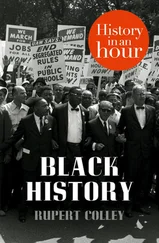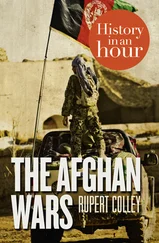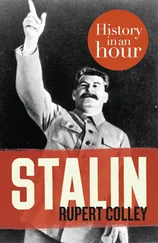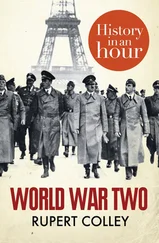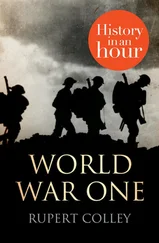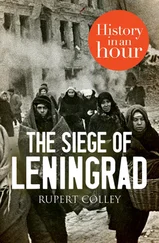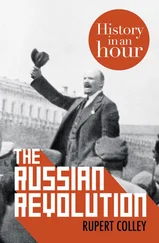The Kapp Putsch, as it became known, may have failed but it illustrated the feeling of anger among the extreme right in Germany. Among the many small political parties was the German Workers’ Party or, to use its German abbreviation, DAP, set up in 1919 by 35-year-old Munich locksmith, Anton Drexler. The DAP, a far-right party that aimed at appealing to the workers, consisted of only about fifty members but, to give the impression of greater numbers, began their membership cards at number five hundred.
It was to a meeting of this party that in September 1919 Adolf Hitler, at this stage being groomed by the army as a political instructor, was sent to observe and speak. The beer hall meeting consisted of only about twenty attendees but Hitler’s speech so impressed Drexler that he was invited to join the party. With membership number 555, although he later claimed in Mein Kampf that he was the seventh member, he signed his name as ‘Hittler’.
NSDAP: Nationalism and Socialism under One Roof
Hitler’s oratory and leadership skills were evident and he soon took over from Drexler as the DAP’s leader. On 24 February 1920, still maintaining its peculiar mix of right extremism and socialist ideals, the party lengthened its name to the Nationalist Socialist German Workers’ Party, or NSDAP. Now boasting 3,000 members, the Nazi Party was born. Two months later Hitler resigned from the army to concentrate full time on expanding his party.
Corporal Hitler
Born in 1889 in Austria, Hitler spent much of his youth in Vienna, living in cheap accommodation, frequenting coffee houses and trying to sell his paintings. Art was his passion and his failure to secure a place at art school plunged him into depression. Resentment of the Jew was rife in the city and Hitler absorbed this anti-Semitism and, like many of his contemporaries, believed the Jew to be set apart from ‘the rest of humanity’.
At the outbreak of the First World War Hitler was in Munich and, having managed to avoid conscription into the Austrian army, signed up to a Bavarian regiment within the German army. He served as a messenger and did so with distinction throughout the war. Having no aspirations for promotion, he finished the war as a corporal having twice been awarded the Iron Cross and twice wounded – the second time in October 1918 when he was temporarily blinded by mustard gas.
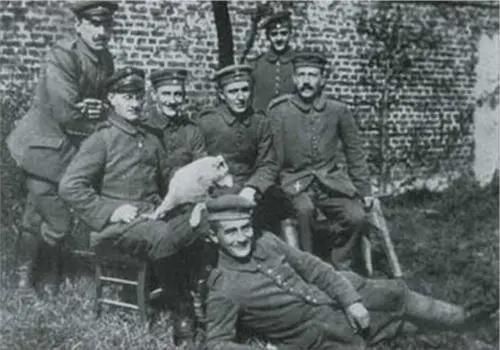
Adolf Hitler (right) during the First World War
It was during his recuperation that the armistice was signed, leaving Hitler and many other Germans embittered. Germany had won the war in the east, and following the ‘Spring Offensive’ of 1918, looked well placed to win it in the west. But a strike of German munitions workers towards the end of the war, believed to have been organized by Jews, disrupted the supply of arms and the front-line soldier suffered as a consequence. The government had accepted defeat and it was they, not the soldier, who had lost Germany the war. The signing seven months later of the Treaty of Versailles confirmed this sense of betrayal, the feeling that the German people had been ‘stabbed in the back’.
As the new leader of the fledging Nazi Party, Hitler met Hermann Göring and Rudolph Hess, two men who would serve him well over the next twenty years, and Ernst Röhm (pictured with Hitler), a tough ex-soldier and former member of the Freikorps, who went on to form the Nazi Storm Troopers (or SA).

Hitler and Röhm, 1933
Bundesarchiv, Bild 146-1982-159-21A / Unknown / CC-BY-SA
The Nazi Manifesto: A Thousand Years The Nazi Manifesto: A Thousand Years Munich Putsch: ‘The national revolution has begun.’ Mein Kampf: ‘Lies, Stupidity and Cowardice.’ The Ruhr: An Economic Downturn The Great Depression: The Crash Nazi Elections: ‘He can lick stamps with my head on them.’ Enabling Act: ‘Fanatics, hooligans and eccentrics have got the upper hand.’ The First Anti-Jew Laws: ‘Non-citizens’. Night of the Long Knives: ‘The Führer’s soldierly decision and exemplary courage.’ The Führer: 99 per cent approval Nazi Germany and the Economy: ‘Guns will make us strong; butter will make us fat.’ State Control: Guilty Before Innocent The Family: ‘I detest women who dabble in politics.’ Propaganda: ‘Where they burn books, they will also ultimately burn people.’ The Olympics Kristallnacht: The Night of Broken Glass Foreign Policy: ‘Germany will of its own accord never break the peace.’ The Rhineland: ‘We have no territorial claims to make in Europe.’ The Spanish Civil War: ‘Germany’s destiny for good or bad.’ Anschluss: ‘I can strongly recommend the Gestapo to one and all.’ The Sudetenland: ‘The last major problem to be solved.’ Czechoslovakia: ‘That senile old rascal.’ Poland – Guaranteed Germany’s War 1939: ‘This country is at war with Germany.’ Germany’s War: 1940 to 1941 Germany’s War: 1942 to 1945 Appendix 1: Key Players Appendix 2: Timeline of Nazi Germany Copyright Got Another Hour? About the Publisher
In February 1920 the party drew up its manifesto which, among its twenty-five points, demanded the union of all Germans into a greater Germany, and called for an expansion of living space to accommodate the growth of the German race. This space, Lebensraum , was to be found in the east at the expense of the Slavic races, who would, according to the party, be simply evicted.
The manifesto rejected the Treaty of Versailles – Germany needed to find her pride again and to rid the nation of the traitors who had so meekly accepted the peace of 1919. Hitler would lead such a Germany, a Third Reich that would reign for a thousand years.
The Jew, the source of German humiliation, was not and could not, stated the manifesto, be German. The manifesto maintained within its nationalist and anti-Semitic principles ones that were socialist in nature, designed to broaden its appeal to the German workers.
Nazism relied on the use of symbols – the swastika, which although far from new, was already identified with the Nazis, and, fifteen years later, in September 1935, was officially adopted as the national flag of Germany alongside a black, red and white tricolour. In September 1935, the flag of the Nazi Party was established as the. In Mein Kampf Hitler wrote about the colours of the flag: ‘In the red we see the social idea of the movement; in the white, the nationalist idea and in the swastika the vision of the struggle for the victory of the Aryan man.’
Munich Putsch: ‘The national revolution has begun.’ Munich Putsch: ‘The national revolution has begun.’ Mein Kampf: ‘Lies, Stupidity and Cowardice.’ The Ruhr: An Economic Downturn The Great Depression: The Crash Nazi Elections: ‘He can lick stamps with my head on them.’ Enabling Act: ‘Fanatics, hooligans and eccentrics have got the upper hand.’ The First Anti-Jew Laws: ‘Non-citizens’. Night of the Long Knives: ‘The Führer’s soldierly decision and exemplary courage.’ The Führer: 99 per cent approval Nazi Germany and the Economy: ‘Guns will make us strong; butter will make us fat.’ State Control: Guilty Before Innocent The Family: ‘I detest women who dabble in politics.’ Propaganda: ‘Where they burn books, they will also ultimately burn people.’ The Olympics Kristallnacht: The Night of Broken Glass Foreign Policy: ‘Germany will of its own accord never break the peace.’ The Rhineland: ‘We have no territorial claims to make in Europe.’ The Spanish Civil War: ‘Germany’s destiny for good or bad.’ Anschluss: ‘I can strongly recommend the Gestapo to one and all.’ The Sudetenland: ‘The last major problem to be solved.’ Czechoslovakia: ‘That senile old rascal.’ Poland – Guaranteed Germany’s War 1939: ‘This country is at war with Germany.’ Germany’s War: 1940 to 1941 Germany’s War: 1942 to 1945 Appendix 1: Key Players Appendix 2: Timeline of Nazi Germany Copyright Got Another Hour? About the Publisher
Читать дальше
